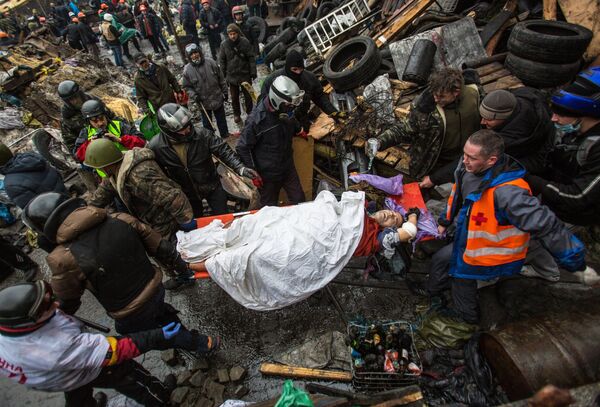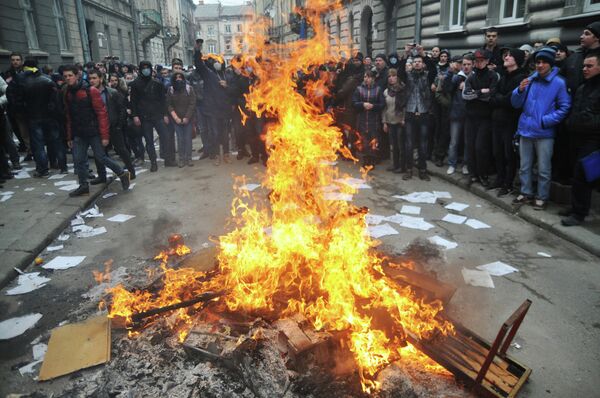LVIV, February 22 (Howard Amos, RIA Novosti) – As battles raged on the streets of Ukraine’s capital in the bloodiest week of a three month-long uprising, the city of Lviv was already installing a new order.
Lviv, situated about 500 kilometers west of Kiev, has served as a crucible for the movement that looked Saturday to have chased President Viktor Yanukovych from government, or at least out of the capital.
As news emerged of dozens killed in fighting in Kiev on Wednesday, a jittery calm had descended on Lviv, a city of 730,000 people near the Polish border.
Later that day, crowds of men in regular civilian clothes gathered to form self-organized protection squads to replace the policemen that had fled after a spasm of anti-government rage in the city.
The following evening they returned in even greater numbers. Most were on foot, others came by cars, bicycle and even on horseback.
“What the police should be doing, the people are doing,” said Oleg, one of the volunteers. “All we have are telephones, our friends and our pride.”
That was not the whole truth, however. Some carried batons, and one admitted he was armed with an air gun.
Things changed in Lviv during the early hours of Wednesday morning when mobs of local people reacted to news of violence in Kiev by attacking police stations, the prosecutor’s office and the local branch of the security services with Molotov cocktails and cobblestones.
The city’s mayor, Andrei Sadovyy, received desperate calls from police commanders, but ignored them. “You can’t stop a tsunami,” he said Saturday, recalling that fateful evening.
And that was when the police disappeared.
“People are very angry,” said Sergei Savchenko, another volunteer, speaking about the need to create the militia-type units. “If we don’t do this, the city will burn, we have to have order.”
Sadovyy told reporters Friday that he had restricted the sale of alcohol, and over 2,500 volunteers had been on patrol the previous night.
Behind the scenes, police were working with the civil defense squads, he said.
Many local people said attacks on their precincts in the city had forced the police to pick sides – and they had chosen the protesters.
“The police are on the side of the people now,” said Oksana Pogorzhelskaya, a pensioner coming out of a church Friday.
Lviv police chief Sergei Zyubanenko said Friday that some police had taken sick leave in order to avoid difficult decisions, but that they must make up their minds about who they support.

“Most police are on the side of the population of the city,” Zyubanenko said. “We will not carry out any criminal orders… this should not be seen as betrayal.”
There was little consensus among officials and ordinary people in Lviv interviewed ahead of the weekend about who had been behind the violence that broke out earlier in the week. Officials have said that two people died at a blaze at a military facility during the unrest.
Blame was alternatively ascribed to provocateurs with links to the security forces, radicals, misguided young people and foreigners.
But some said it was justified by events in Kiev where dozens were killed in clashes between riot police and protesters.
“It had to be done otherwise nobody would have listened to us,” said Lviv resident and student Solamiya Pavliv, whose father has traveled to Kiev to assist on Independence Square, the focal point of the anti-government movement.
Still, despite a sense of victory, the political landscape appeared uncertain in Lviv this week with different elected bodies apparently vying for control.
The governor, appointed by President Viktor Yanukovych, was ousted by protesters last month and retains little real authority.
Nationalist party Svoboda deputy head in Lviv said in an interview Friday that the elected regional parliament was in charge.
“[The current structure] could be the basis for a change of power,” said Andrei Pshyk.
Others, however, appear to be loyal to mayor Sadovyy, who has been coordinating security with the police and the civil defense volunteer units.
Sadovyy urged the Ukrainian parliament Saturday to pass legislation that would decentralize power, arguing that such a step was the route to democracy.
Lviv has been heavily invested in the current anti-government protests in Kiev since they began in November, when Yanukovych backed off from signing key trade agreements with the European Union.
Organizers said Friday that about 1,000 people a day were still leaving for the capital. Dispatch points contain huge piles of shields, helmets, gas masks and medical equipment stacked for delivery to the capital.
The city’s role in sustaining the demonstrations against Yanukovych has come at a cost, however. At least 13 people from Lviv, including one student, have been killed in recent days of deadly clashes in Kiev.
About 2,000 mourners turned out Saturday for a funeral service for one of those who died: Bogdan Solchanik, a 28-year-old teacher at Lviv’s Ukrainian Catholic University, who was killed, friends said, by a sniper’s bullet to the neck.
When the coffin, draped in a Ukrainian flag, was carried out of the Greek Catholic Saint Peter and Paul Church it was met with a rendition of the Ukrainian national anthem and chants of “hero, hero, hero” and “heroes do not die” from the crowd.
Outside the church, Pavlo Salo said he first met Solchanik in 2003 and was with him as the firing started on Independence Square on Wednesday morning. He ran back to fetch a shield and the two were separated. He only found his friend a few hours later among 13 bodies outside a McDonalds.
He said he then phoned Solchanik’s girlfriend in Lviv.
“I didn’t know how I would look her in the eyes after that. It was very difficult, there was panic, there was hysteria and tears,” he said.
Those gathered for the service said that, despite the suffering families, no one had died in vain in Kiev.
“They didn’t have a uniform but they had powerful hearts,” said Stepan Sus, the dean of the church where the service for Solchanik was held.
“They are heroes of 21st century Ukraine who will be an example for our children.”


